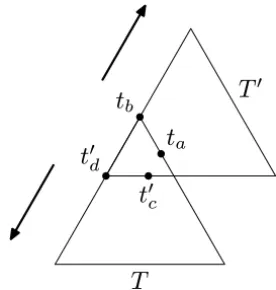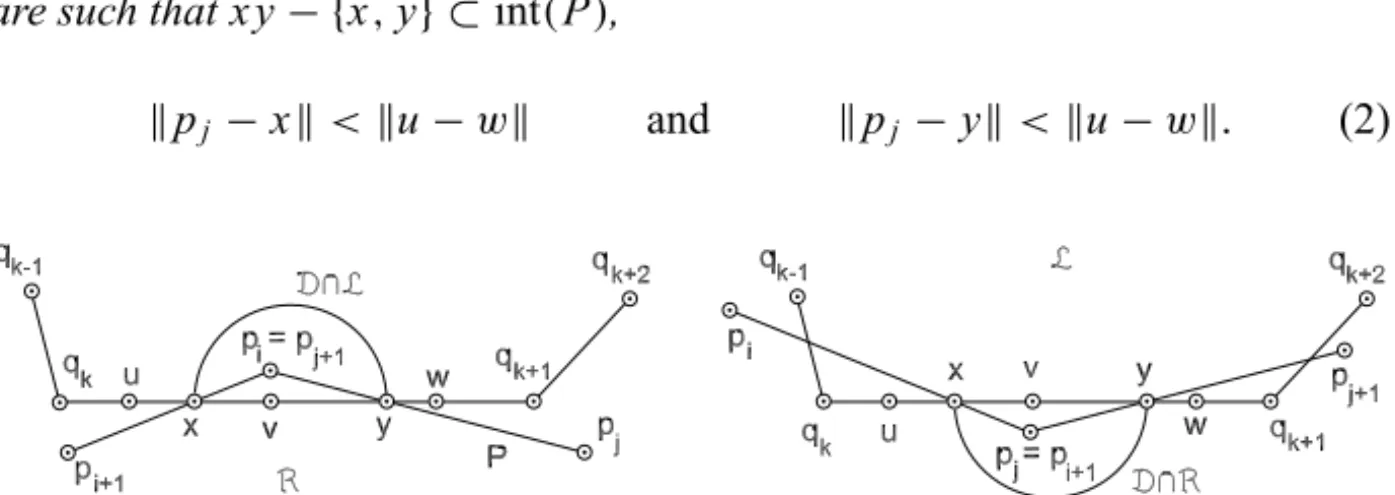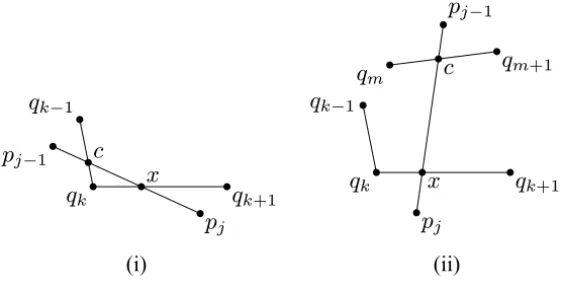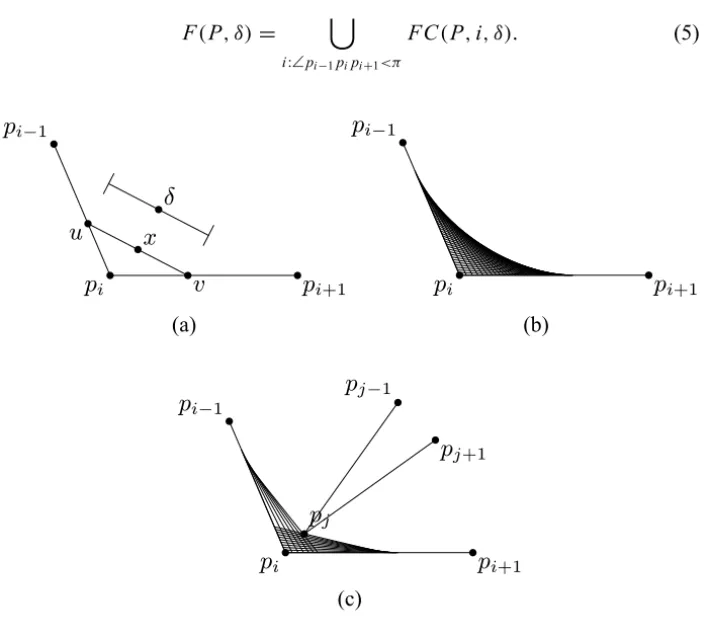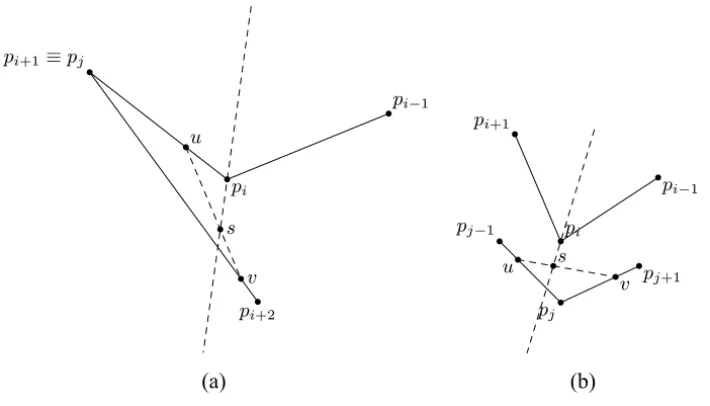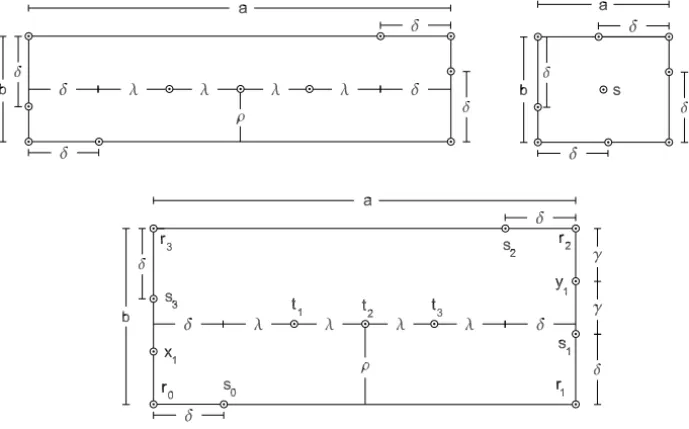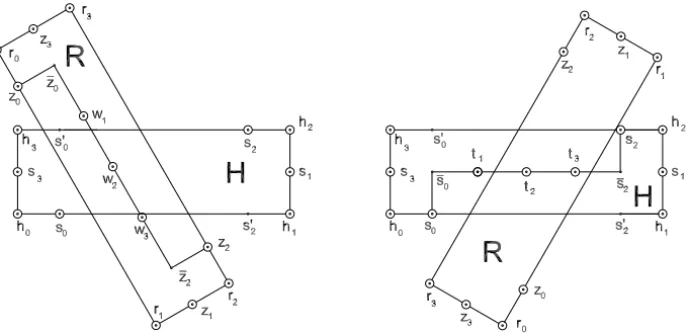ISSN 0101-8205 www.scielo.br/cam
Using sentinels to detect intersections of convex
and nonconvex polygons
W.F. MASCARENHAS and E.G. BIRGIN
Computer Science Department, Institute of Mathematics and Statistics University of São Paulo, Rua do Matão, 1010, Cidade Universitária
05508-090 São Paulo, SP, Brazil
E-mails: walterfm@ime.usp.br/ egbirgin@ime.usp.br
Abstract. We describe finite sets of points, called sentinels, which allow us to decide if isometric copies of polygons, convex or not, intersect. As an example of the applicability of the concept of sentinel, we explain how they can be used to formulate an algorithm based on the optimization of differentiable models to pack polygons in convex sets.
Mathematical subject classification: 90C53, 65K05.
Key words:sentinels, polygons, intersection, packing, nonlinear programming.
1 Introduction
In [1] we propose a nonlinear programming approach to pack arbitrary poly-gons in convex sets (not necessarily polypoly-gons). This approach is based on the observation that if the interior of translated and rotated copies P′ andQ′of the polygonsPandQin Figure 1 intersect then either the interior ofP′contains one
of the pointsqi′ or the interior of Q′ contains some p′
i. Motivated by this fact,
we say that the pi andqi are sentinelsfor {P,Q} with respect to translations
and rotations.
The observation above leads to the following algorithm to pack translated and rotated copies ofP1,P2, . . . ,PNon a convex setC:
Figure 1 – The points pi and qi are sentinels: they detect if translated and rotated
copies of the interior ofPandQintersect. In this examplep4′ is in the interior ofQ′.
1. We parameterize Pi by the coordinates (xi,yi) of its barycenter and its
rotation angleθi.
2. We define differentiable functions9i j(xi,yi, θi,xj,yj, θj)based on the
distance of the sentinels of Pi to Pj so that 9i j(xi,yi, θi,xj,yj, θj)
is zero if all the sentinels of Pi are outside the interior of Pj and 9i j(xi,yi, θi,xj,yj, θj) is positive otherwise. (See [1] for an example
of9i j-functions for identical rectangles.)
3. We find approximations to the solution of the feasibility problem
9i j xi,yi, θi,xj,yj, θj
=0 and vertices of Pi ⊂C. (1)
For each solution of problem (1) we obtain a packing ofP1,P2, . . . ,PNinC.
In [1] we describe the nonlinear programming aspects of the approach above in detail, from the theoretical and practical perspectives. In [5, 7, 8], Stoyan’s
8-functions are introduced. A8-function for a pair of polygons is defined as a function whose value is positive if the polygons overlap and zero otherwise. Our functions9 are analogous to Stoyan’s8-functions in the sense that they are8-functions defined through the usage of sentinels. Sentinels can also be used to detect the intersection of rotated and translated copies of polygons [6]. Finally, the concept of sentinel leads to packings which are not necessarily lat-tice-like [3].
discuss their existence and complexity. Sentinel is a neat concept, but unfor-tunately some polygons require an infinite number of them. For instance, if instead of the polygons PandQin Figure 1 we consider translated and rotated copies of a single triangleT then no finite set of points{t1, . . . ,tn}, no matter
how large, would be enough to detect all the intersections ofT and a translated copyT′ of it: see Figure 2; we can always translate T′ (maintaining the over-lapping withT) in order to havet′
coutsideT andtaoutside ofT′no matter how
near we definetafromtbandtc′fromt ′ d.
t
bt
aT
t
′d
t
′c
T
′Figure 2 – There are no finite sets of sentinels for triangles. No matter how near we definetaandtbforT andtc′andtd′ forT′, it will always be possible to overlapT andT′
havingtc′ ∈/T andta∈/ T′.
Small internal angles are the main reason why we may need an infinite num-ber of sentinels. More precisely, in the next section we show that ifPis a finite
family of convex and non-convex polygons P such that all the internal angles ofP are bigger than or equal toπ/2 then we can assign a finite set S(P)⊂R2
to each P ∈ P in such way that ifT,U :R2 → R2 are isometries, P,Q ∈ P
2 Sentinels
In this section we formalize the concept of sentinel and prove the existence of finite sets of sentinels for relevant families of polygons. We start by defining the basic terms we use:
Notation 1. Ifu,v ∈ R2 then we call the segment with extremesu andv by
uv.
Convention 1. A polygon P is defined in terms of an integer n ≥ 3 and verticespi ∈R2, fori ∈Z, such that
(a) pi+n= pi for alliand pi+j 6= pi if jis not a multiple ofn.
(b) pi ∈/ pi−1pi+1for alli.
(c) If the segments pipi+1and pjpj+1intersect then either (i) i ≡ j mod n, or
(ii) i ≡ j+1 mod n and pipi+1∩ pjpj+1= {pi}, or
(iii) i+1≡ j mod n and pipi+1∩ pjpj+1= {pj}.
These conditions imply that Pis a Jordan curve. We denote the interior of this curve by int(P) and its border by border(P). Moreover, we assume that the points pi are in counterclockwise order and usen(P)to denoten.
Notation 2. Sub(R2)denotes the set whose elements are the subsets ofR2.
Using this terminology we can formalize the concept of sentinel:
Definition 1. LetP be a family of polygons and letT be a family of transfor-mations T :R2 →R2such that T(P)is a polygon for all P ∈P. We say that a function S :P → Sub(R2)is a sentinel assignment for P with respect toT if for all T , U ∈ T and P, Q ∈ P such thatint(T(P))∩int(U(Q)) 6= ∅we have that eitherint(T(P))∩U(S(Q)) 6= ∅orint(U(Q))∩T(S(P))6= ∅. In this context, we say that the elements of S(P)are the sentinels of P.
Notation 3. The isometries of R2 are transformations of the form T(x) = Qx +d, whereQis a 2×2 orthogonal matrix andd ∈R2. We call the set of such isometries byI2. We defineI2+as the set of transformationsT above with
detQ=1.
In this section we provide sufficient conditions on the familyPof polygons to
guarantee the existence of a sentinel assignmentSforPwith respect toI2such
thatS(P)is finite for all P ∈ P. In the next section we discuss the analogous
question whenP is a family of rectangles and the family of transformations is I2+. These conditions are expressed in terms of the parameterα(P):
Notation 4. We call the smallest internal angle of the polygon Pbyα(P).
The relevance ofα(P)is illustrated in Figure 3. According to this figure, we can decide whetherb is inside, over or outside the circle with diameterac by looking at the angleα. This figure is the motivation for the conditionα(P)≥π/2 used throughout this paper.
Figure 3 – The angleαand the position ofbwith respect to the circle with diameterac.
Besidesα(P)our results are formulated using the sets1(P):
Definition 2. Let P be a polygon with n ≥ 4vertices (remember that we are dealing with convex and nonconvex polygons). We define1(P)as the set formed by the positiveδ’s such that every segment uvconnecting disjoint sides of P has
length bigger thanδ.
properties of polygons. For instance, the supremum of our sets 1(P) could be related to the several attempts to quantify the fatness of a polygon (see [4]) but our approach is different: we look at the whole set1(P), not only at its supremum.
If P is convex andα(P) > π/2 then1(P)=(0, μ(P)], whereμ(P)is the length ofP’s shortest side. In this particular case the arguments below could be rephrased in terms ofμ(P). However, in [1] we care mainly about rectangles and if Ris a rectangle then1(R) =(0, μ(R))does not containμ(R). Therefore, in order to unify the treatment of rectangles and polygons with bigger internal angles we chose to use1(P).
Usingα(P)and1(P)we can state the key results behind most arguments in this paper. Given a familyP of polygons and a function S : P → Sub(R2), Theorems 1 and 2 give sufficient conditions forSto be a sentinel assignment for
Pwith respect to I2. Lemmas 1, 2 and 3 present technical results used to prove
the theorems.
Lemma 1. Let P and Q be polygons with α(P) ≥ π/2 andα(Q) ≥ π/2. Suppose u,v,w∈qkqk+1are such thatku−qkk<kv−qkk<kw−qkkand (a)u, w6∈int(P), (b) v∈int(P) and (c)ku−wk ∈1(P)∩1(Q).
If no vertex of P is in the interior of Q then there exists a vertex pj of P with
pj−1pj ∩uv = {x}and pjpj+1∩vw = {y}(see Fig. 4). Moreover, x and y are such that x y− {x,y} ⊂int(P),
kpj −xk<ku−wk and kpj −yk<ku−wk. (2)
Figure 4 – The conceivable situations for p ∈ pipi+1∩ pjpj+1. Actually, only the
Proof of Lemma 1. Let x y be the biggest segment contained in qkqk+1 such that v ∈ x y and x y − {x,y} ⊂ int(P) and consider the sides pipi+1 andpjpj+1such thatx ∈ pipi+1andy ∈ pjpj+1. Items (a) and (b) imply that x y ⊂uw. Item (c) shows thatkx−yk ≤ ku−wk ∈1(P). Sincex ∈ pipi+1 and y ∈ pjpj+1, the definition of 1 implies that pipi+1 ∩ pjpj+1 6= ∅. Let p∈ {pj,pj+1}be the common vertex of pipi+1andpjpj+1. According to
Figure 3, pbelongs to the diskD= {z ∈R2withk2z−(x+y)k ≤ kx−yk}. If L and R are the open half planes on the left and right sides of the line qkqk+1then, in principle, we have the two possibilities regarding pdescribed in Figure 4. However, the situation on the left side of this figure does not occur, becauseD∩L ⊂int(Q)and there is no vertex of P in int(Q)by hypothesis.
In fact, notice thatD∩L cannot intersect sides of Q which are
nonconsecu-tive toqkqk+1because (c) implies that the distances from such sides toqkqk+1 is bigger than the radius ofD. Moreover,D∩Ldoes not intersect the sides qk−1qk andqk+1qk+2either, because the internal angles of Q are at least π/2. This implies thatD∩Lis contained in the interior of Qand, thus, p∈/D∩L
as we claimed. Therefore, we must have p= pj = pi+1∈D∩Ras described in the right side of Figure 4 and the bounds in (2) holds because the diameter ofD is at mostku−wk. (For further reference, as pi+1 ≡ pj, we will refer
topipi+1as pj−1pj.)
Lemma 2. Let P, Q and{x} =qkqk+1∩pj−1pj as in Lemma1. Assume that
x 6= qk and let c ∈ bor der(P)∩bor der(Q) be the first point different from
x encountered when walking x pj−1from x to pj−1(see Fig. 5)1. Then, either c∈qk−1qk− {qk} and kx−ck>max{kc−qkk,kqk−xk}, (3)
or
c 6∈qk−1qk∪qkqk+1 and kx −ck ≥sup1(Q). (4)
Proof of Lemma 2. Letqmqm+1be the side of Qcontainingc. We will first show that qmqm+1 6= qkqk+1 and qmqm+1 6= qk+1qk+2. Since x ∈ qkqk+1 −
1Note that p
j−1pj ∩uv = pj−1pj ∩qkqk+1 = {x} 6= qk implies that the segments
qk−1
qk qk+1
pj−1
pj
c x
qk−1
qk qk+1
qm
qm+1
pj−1
pj
c
x
(i) (ii)
Figure 5 – The situations (i) and (ii) described in Lemma 2.
{qk}, c ∈ qmqm+1 and ∅ 6= xc − {x,c} ⊂ int(Q) we have that x and c are in different sides of Q and, in consequence,qmqm+1 6= qkqk+1. Considering
the triangle with vertices x pjy (right hand side of Fig. 4) and knowing that ∠x pjy = ∠pj−1pjpj+1 ≥ π/2 we have that∠qkxc ∼=∠pjx y < π/2. Then ∠qkxc < π/2 implies that ∠qk+1xc > π/2. This and∠qkqk+1qk+2 ≥ π/2 imply that the half linesx+γ1(c−x)andqk+1+γ2(qk+2−qk+1),γ1, γ2≥0, never intersect. Thus,c∈/qk+1qk+2andqmqm+16=qk+1qk+2.
Therefore, we have only these two possibilities regardingqmqm+1:
• qmqm+1=qk−1qk. In this casekx−ck>max{kc−qkk,kqk−xk}because
xcis the biggest side in the (nonempty) triangle with vertices xqkc, since
the angle∠xqkcis equal to∠qk+1qkqk−1, which is at leastπ/2.
• qmqm+1 6= qk−1qk. In this case, by definition of1, kx −ck > δfor all δ∈1(Q). This implies thatkx−ck ≥sup1(Q).
Clearly, a symmetric result can be obtained for{y} =qk−1qk∩pjpj+1defined in Lemma 1.
Part of the hypothesis of the main theorem in this section requires that each polygon inPhas an internal sentinel outside theforbidden region F(P, δ)that
we now describe. SupposeP is a polygon andδ >0 satisfiesδ≤ kpi+1−pik
for alli. For each vertex pi ofP we define the forbidden cornerFC(P,i, δ)as
FC(P,i, δ)=
(see Fig. 6) and we define the forbidden region
F(P, δ)= [
i:∠pi−1pipi+1<π
FC(P,i, δ). (5)
p
i−1p
ip
i+1u
v
x
δ
p
i−1p
ip
i+1(a) (b)
p
i−1p
ip
i+1p
j−1p
jp
j+1(c)
Figure 6 – The forbidden cornerFC(P,i, δ).
The next lemma shows that we can always find internal sentinels outside the forbidden regions for any polygon withn>3 vertices.
Lemma 3. If P is a polygon with n > 3vertices andδ ∈ 1(P)then the set int(P)−F(P, δ)is not empty.
Proof of Lemma 3. We analyze convex and non-convex polygons separately.
Let us start with P convex. For eachi = 0, . . . ,n−1 let Pi be the convex
polygon with vertices{p0, . . . ,pn−1} − {pi}. Note that
for every tripleti, j,k. Therefore, Radon’s theorem implies that
A=
n−1
\
i=0
Pi 6= ∅.
The setAdoes not contain vertices or sides of P. Thus,A⊂int(P). Moreover, the interior of the ears of P do not intersect A. It is clear then that int(P)− F(P, δ)⊃ A6= ∅and we are done with the convex case.
If P is not convex then there exists at least one i such that the angle
∠pi−1pipi+1is bigger thanπ. Letǫ ∈(0, δ/4)be such that s =sǫ = pi −ǫ
pi+1− pi
kpi+1− pik
+ pi−1−pi kpi−1−pik
belongs to int(P). Geometrically (see Fig. 7),sis a point in the bisectrix of the angle∠pi−1pipi+1very close to pi:
kpi −sk ≤ǫ
pi+1− pi
kpi+1− pik
+ pi−1−pi kpi−1−pik
≤2ǫ < δ/2.
To complete this proof we will show thats ∈int(P)−F(P, δ), i.e., it does not belong to any forbidden cornerFC(P, j, δ)with∠pj−1pjpj+1< π. Consider a forbidden corner FC(P, j, δ)as above. Let u ∈ pj−1pj andv ∈ pjpj+1be such thats ∈uv,uv− {u, v} ∈int(P). To prove thats ∈/ FC(P, j, δ)is enough to show thatku −vk ≥ δ. Noticing that∠pj−1pjpj+1 < π < ∠pi−1pipi+1 impliesi6= j, we are left with the three cases:
(i) j =i+1 (described in Fig. 7a),
(ii) j =i−1 (described, after reflection, in Fig. 7a),
(iii) j 6∈ {i−1,i,i+1}(described in Fig. 7b).
Cases (i) and (ii) differ only by a reflection and we will threat both as case (i). Let us start with case (i). Since P has more than three vertices, we have that pi−1pi and pi+1pi+2are not consecutive. Thus, by definition of1(P)we have thatkpi −vk> δ. Now,
pi+2 pi+1≡pj
pi
pi−1
u
v s
pi+1
pi
pi−1
pj−1
pj
pj+1 u
v s
(a) (b)
Figure 7 – The two cases that illustrates the proof of Lemma 3.
This implies thatku −vk > kpi −vk > δ and we are done with cases (i)
and (ii).
Finally, let us handle case (iii). In this case the sides pipi+1and pjpj+1are not consecutive. Thus, by definition ofδ,kpi −vk> δ. As a consequence,
kv−sk ≥ kpi−vk − ks−pik> δ−δ/2=δ/2. (6)
Analogously, since the sides pi−1pi and pj−1pj are not consecutive we get that
kpi−uk> δand then
ks−uk ≥ kpi−uk − ks−pik> δ−δ/2=δ/2. (7)
Combining (6) and (7) we get
ku−vk = ku−sk + ks−vk> δ/2+δ/2=δ
and the proof is complete.
Now we can address the main question of this section: Given a family P of
Theorem 1. LetPbe a family of polygons such that, for each P ∈P,α(P)≥
π/2. Let S be a function fromPtoSub(R2). Assume that for all P∈P
(a) S(P)contains the vertices of P;
and that there existsδ∈T
P∈P1(P)for which
(b) for each side pipi+1 of P there exist ni ∈ N and sj ≡ pi +(γj/ Ŵ) (pi+1− pi) ∈ S(P), whereŴ = kpi+1− pik, such thatγj ∈ [0, Ŵ]for
j =1, . . . ,ni, if ni 6= 0then γ1 = δ andγni = Ŵ−δ,γj < γj+1 and
|γj −γj+1| ≤δfor j =1, . . . ,ni−1;
(c) the set S(P)contains a point inint(P)−F(P, δ).
Then S is a sentinel assignment forPwith respect to I2.
Proof of Theorem 1. Consider membersAandBofPandT,U ∈ I2. Define P = T(A), Q = U(B), S(P) = T(S(A)) and S(Q) = U(S(B)). Since T andU are isometries, hypotheses (a), (b) and (c) also apply to P and S(P)
and Q and S(Q). To prove Theorem 1, we assume that there exists a point z ∈int(P) ∩ int(Q)and show that either
S(P) ∩ int(Q)6= ∅ or S(Q) ∩ int(P)6= ∅. (8)
Hypothesis (c) implies that there exists s ∈ S(P) ∩(int(P)− F(P, δ)). If s ∈int(Q)then the first condition in (8) is satisfied and we are done. Thus, we assume thats 6∈ int(Q). Sinces andz are in the interior of the Jordan curve P, there exists a continuous path contained in the interior of P connectings toz. This path intersects border(Q)at some point vbecauses 6∈ int(Q) and z ∈int(Q). Ifv∈ S(Q)then the second condition in (8) is satisfied and we are done again. Thus, we only need to care about the case in whichv 6∈S(Q)and
vis the first intersection of the path above and border(Q), that is, there exists a continuous functionφ : [0,1] →R2such that
φ(0)=s, φ(1)=v, φ([0,1])⊂int(P) and φ ([0,1))∩Q = ∅. (9)
Figure 8 – The relative position of pj,s,u,vandwwhen{u, w} ∩int(P)= ∅.
kw−qkk. Ifuorwbelong to int(P)then the second condition in (8) is
satis-fied and we are done. To complete this proof, let us now derive a contradiction from the assumption that hypothesis (c) holds and neither u norw belong to int(P). In this case Lemma 1 implies that there exist pj−1,pj andpj+1, vertices
ofP, and{x} = uv∩ pj−1pj,{y} = vw∩ pjpj+1andx y− {x,y} ⊂ int(P) like the ones in Figure 8.
This figure is also accurate regarding the fact that s is in the interior of the triangleτ = x pjy. In fact, (9) implies that the path φ ([0,1]) does not cross
x pj nor pjyandφ([0,1))does not touchyx. Moreover, ifǫis smallφ(1−ǫ)
is close tovand outside Q. This implies thatφ (1−ǫ) ∈ int(τ )for ǫ small. Sinceφ ([0,1)] does not touch border(τ ) we have thatφ([0,1)) ⊂ int(τ ). In particular,s =φ (0)∈ int(τ ). However, equation (2) shows thatkx −pjk ≤ δ
andkpj − yk ≤ δ. This implies that int(τ ) ⊂ FC(P, j, δ) and we deduce
thats ∈ F(P, δ). This conclusion contradicts our choice ofs at the beginning
of this proof.
Theorem 1 implies that ifPis a finite family of polygonsPwithα(P)≥π/2
then there exists a sentinel assignmentSforPwith respect toI2such that S(P)
is finite for allP ∈P: take an arbitrary choice ofδ ∈T
P∈P1(P), for example,
δ= 1 3sup
\
P∈P
1(P) >0,
and for eachP∈Pchoose a finite setS(P)of sentinels that satisfy the conditions
(a)–(c) in Theorem 1. Lemma 3 guarantees that it is possible to find a point satisfying condition (c) of Theorem 1.
Corollary 1. Letδ > 0and letP be a family of convex polygons such that, for all P ∈ Pwe have thatα(P) > π/2and all sides of P have lengthδ. For P ∈Ptake s ∈int(P)−F(P, δ)and define S(P)= {s,p1,p2, . . . ,pn(P)}. The
function S is a sentinel assignment forP regarding I2. (S satisfies hypotheses (a)and(c)by definition and hypothesis(b)with ni =0.)
We have seen that Theorem 1 can be used to construct sentinel assignments for certain families of polygons or to verify that a given assignment Sthat satisfies the hypotheses of Theorem 1 is a sentinel assignment. However, there is a simple and important case that is not covered by Theorem 1. Consider a familyP of
identical squares P of sided. In this case we have that1(P) =(0,d)for all P ∈P. Letδ= 1
2d. Consider a sentinel assignmentSforPsuch that, for each P ∈P,S(P)is given by a sentinel in each vertex ofP, a sentinel in the middle of each side ofPand a sentinel in int(P)−F(P, δ). ThisSsatisfies hypotheses (a) and (b) but does not satisfy hypothesis (c) of Theorem 1. Therefore, Theo-rem 1 can not be used to certify that S is, in fact, a sentinel assignment forP.
The theorem below is similar to Theorem 1 except for the fact that hypothesis (c) is replaced by a couple of other hypotheses satisfied by the sentinel assign-ment described above.
Theorem 2. LetPbe a family of polygons such that, for all P ∈ P,α(P)≥
π/2. Let S be a function fromPtoSub(R2). Assume that for all P∈P
(a) S(P)contains the vertices of P;
and that there existsδ∈T
P∈P1(P)that satisfies
(b) for each side pipi+1of P there exist ni ∈Nand sj ≡ pi+(γj/ Ŵ)(pi+1− pi) ∈ S(P), where Ŵ = kpi+1− pik, such that γj ∈ [0, Ŵ] for j =
1, . . . ,ni, if ni 6= 0 then γ1 = δ and γni = Ŵ−δ, γj < γj+1 and
|γj −γj+1| ≤δfor j =1, . . . ,ni−1;
(c) S(P)∩int(P)6= ∅; and
(d) kpi+1−pik ≥2δfor all i ∈Z.
Proof of Theorem 2. This proof follows very closely the proof of Theorem 1. Thus, we will assume that there exists a pointz ∈ int(P) ∩ int(Q)and show that either
S(P) ∩ int(Q)6= ∅ or S(Q) ∩ int(P)6= ∅. (10)
By hypothesis (c), there existss ∈S(P)∩int(P)and letv∈int(P)be the first point that belongs to border(Q)encountered when walking the continuous path froms toz trought the interior of P. If s ∈ int(Q)or ifv ∈ S(Q)then (10) holds and we are done. Therefore, we only need to care about the case in which there exists a continuous functionφ : [0,1] →R2such that
φ(0)=s, φ(1)=v, φ([0,1])⊂int(P) and φ ([0,1))∩Q= ∅. (11)
Letqkqk+1be the side of Qthat containsv. Then, hypotheses (a) and (b) imply that there existu, w ∈ S(Q)∩qkqk+1 such that v ∈ uw, ku −wk ≤ δ and ku−qkk < kw−qkk. If S(Q)∩int(P) 6= ∅we are done. So, we assume
thatu, w /∈ int(P). In this case Lemma 1 implies that there exist pj−1, pj
and pj+1, vertices of P, and{x} = uv ∩ pj−1pj and {y} = vw∩ pjpj+1 like the ones in right hand side of Figure 4. Hypothesis (d) and the fact that ku−wk ≤ δ imply that eitheru 6= qk orw 6= qk+1. By symmetry, assume
thatu 6= qk which implies that x 6= qk (in fact, it implies that kx −qkk ≥ δ). In this case, by Lemma 2, there exists c ∈ bor der(P)∩bor der(Q), the first point different from x encountered when walking x pj−1 from x to pj−1 (see Fig. 5), such that either (3) or (4) holds. By (3) and the fact that kx − qkk ≥ δ or by (4) and the fact that δ ∈ 1(Q), we have that kx −ck ≥ δ.
So, we havexc⊂int(Q)∩ pj−1pj andkx−ck ≥δ. By hypothesis (b) there
existst∈ xc∩S(P)and, thus, we have verified (10).
3 Sentinels for rectangles
Figure 9 – The sentinels Sδρ(R). In the top left rectangle a > 2δ ≥ b > δ and
λ = (a −2δ)/nλ for nλ = ⌈(a −2δ)/δ⌉. For the bottom rectangle, b > 2δ and
γ =(b−δ)/nγ withnγ = ⌈(b−δ)/δ⌉. In the top right rectanglea≤2δandb≤2δ.
Formally, given a rectangle R and δ andρ with 0 < δ, ρ < kr3−r0kwe defineSδρ(R)as the set formed by:
1. The verticesr0,r1,r2,r3ofR.
2. The pointssi =ri+δ(ri+1−ri)/kri+1−rikfori =0,1,2 and 3.
3. Ifb>2δ, the pointsxi =s3+i(r0−s3)/nγ andyi =s1+i(r2−s1)/nγ
for 1≤i <nγ, withnγ = ⌈(b−δ)/δ⌉.
4. Ifa >2δ, the pointsti =ρ(r3−r0)/b+(s0−r0)+i1/nτ,for 1≤i <nτ,
with1=r1−r0−2(s0−r0)andnτ = ⌈k1k/δ⌉.
5. Ifa ≤2δ, the points =(r0+r1+r2+r3)/4. The following theorem is the main result in this section:
Theorem 3. LetRbe a family of rectangles and supposeδ∈T
R∈R1(R). If
for all R∈Rwe haveρ(R)∈(0,b(R))such that
b(R′)6∈
then the function S : R → Sub(R2)given by S(R) = Sδρ(R)(R)is a sentinel
assignment forRwith respect to I+
2.
If all rectangles in R ∈ R have δ < b(R) ≤ 2δ then the sets Sδρ(R)(R)
contain only one element in each smaller side of Rand the sentinel assignment Sabove in Theorem 3 is optimal, i.e., if S′is another sentinel assignment forR
with respect to I2+ then S′(R)has at least as many elements as S(R). In fact, S′(R) must contain the vertices of R and at least one element in each side of R. Moreover, if S′(R) does not contain as many elements as S(R) then it is possible to superimpose a copy ofRrotated byπ/2 andRin order to contradict the definition of sentinel assignment.
We end this paper with the proof of Theorem 3:
Proof of Theorem 3. The sets Sδρ(R) and the condition (12) are invariant
underI2+, in the sense that ifT ∈ I2+and R∈RthenSδρ(T(R)) =T(Sδρ(R))
andb(R)=b(T(R)). Therefore, to prove Theorem 3 it is enough to show that ifH andRare rectangles withkh0−h3k ≥ kh1−h2k,kr0−r3k ≥ kr1−r2k and
δ∈1(H)∩1(R), |kr0−r3k − kh0−h3k| 6∈ {ρ(H), ρ(R)} (13) and int(H)∩int(R)6= ∅then
int(H)∩Sδρ(R)(R)6= ∅ or Sδρ(H)(H)∩int(R)6= ∅. (14)
Ifa(H)≤2δanda(R)≤2δthen (14) is a consequence of Theorem 1 applied toP = {H,R}. Thus, we can assume that a(H) = kh1−h0k > 2δ.
More-over, if si are the sentinels described in Figure 9 for H and {h0,h1,h2,h3, s0,s1,s2,s3} ∩int(R) 6= ∅then (14) is satisfied. Therefore, we only need to analyze the case
a(H)=max{a(H),a(R)}>2δ and hi,si 6∈int(R)for i =0,1,2,3. (15)
We leave to the reader, the verification of the fact that ifh0h1andr0r1are parallel then (14) is satisfied2. From now on we analyze the case in whichHis horizontal andRis a rotated rectangle as in Figure 10 or a rotated rectangle witha(R)≤2δ.
Figure 10 – Two ways a rotated rectangleRcould cross the horizontal rectangle H and
do not touchh3h0∪h0s0∪h1h2∪h2s2. Sentinels are indicated by large circles and
auxiliary points have names with superscripts and are represented by small circles.
To avoid conflicting names, we rename R’s sentinels as in Figure 10: thes sentinels for R are called z’s and thet sentinels are called w. Notice that in all polygons R in Figure 9 ifri is a vertex of R then there exists a sentinel zi
at a distanceδ fromri in the counterclockwise direction along R. Repeating
the argument in the second paragraph of the proof of Theorem 1 withu = h0,
w=s0andqk+1=h1, we deduce that if int(R)∩h0s06= ∅then{z0,z1,z2,z3} ∩ int(H) 6= ∅ and (14) is satisfied. Therefore, from now on we assume that int(R)∩ h0s0 = ∅. If R ∩ (h0s0 − {h0,s0}) 6= ∅ then we have only two possibilities:
• h0s0andr1r2are parallel. In this caseh0s0must be contained in the line r1r2and you can check that either (a)s1 ∈int(R), (b)z2∈ int(H)or (c) s1=z2andt1∈int(R).
• h0s0 andr1r2 are not parallel. In this case, since we are assuming that r0r1andh0h1are not parallel and that int(R)∩h0s0= ∅, there is a vertex ri ∈h0s0− {h0,s0}and (15) implies thatzi ∈int(H).
Thus, ifR∩(h0s0− {h0,s0})6= ∅then (14) is satisfied and we can assume that R∩ h0s0− {h0,s0}
Now let us analyze the intersections of Rwith the sideh3h0ofH. Since this side is populated with the sentinelsh3,s3,xi andh0, which are at mostδapart,
Lemma 1 yields that if int(R)∩h3h0 6= ∅then we have a situation like the one in the right side of Figure 4, withqk = h3,qk+1 = h0 andqk+2 = h1 and pj
as one vertexri of R. We claim that in this case zi ∈ int(H). In fact, since
kzi − pik = δ is at least as big as the diameter ofD we have that zi 6∈ riy.
Letd be the point defined in items (iv)–(vi) of Lemma 1. We have this three possibilities:
• dsatisfies (iv): This case case contradicts (16) and need not to be consid-ered.
• dsatisfies (v). In this case we have that
kri−dk>ky−dk ≥sup1(Q)≥δ = kri −zik (17)
andkri−dk> δ. This inequality combined withzi 6∈ziyandkzi−rik =δ
implies thatzi ∈ yd− {y,d} ⊂int(H). Thus,zi ∈int(H)in case (v).
• dsatisfies (vi): In this cased ∈h0h1∩Rand sinceR∩(h0s0−{h0,s0})= ∅ we must have d ∈ s0h1. This implies that kd − h0k ≥ δ and, since qk+1=h0in our context, (iv) implies thatky−dk ≥δ. We can then use the same argument following (17) and conclude thatzi ∈int(H).
In summary, we have shown that if int(R)∩h3h06= ∅then (14) holds. Let us then assume that int(R)∩h3h0= ∅. Using this assumption and (16) it is easy to show that ifR∩(h3h0− {h3,h0})6= ∅then there existsri ∈(h3h0− {h3,h0}) andzi ∈ int(H). Thus, we can assume that R∩(h3h0− {h3,h0}) 6= ∅. This assumption, the fact that int(H)∩int(R)6= ∅and (16) imply thatR∩(h3h0∩ h0s0− {h3,s0})= ∅. Using symmetry we can resume our conclusions up to this point as the statement that either
R∩ h3h0∪h0s0∪h1h2∪h2s2− {h3,s0,h1,s2}
= ∅ (18)
or (14) is satisfied and we assume (18) from now on.
at pointseand f, say. Sincekf −ek> δwe conclude that ifRis “short”, i.e., ifb(R)≤2δ, then{z0,s2} ∩int(H)6= ∅. Therefore, we can assume that
b(R) >2δ and {r0,r1,r2,r3,z0,z2} ∩int(H)= ∅
and thatz0is on or above the lineh2h3andz2is on or below the lineh0h1(These details are illustrated in Fig. 10.) We then have our three final possibilities:
(i) Ifr0r1∩(s0′h3− {s0′})6= ∅thenRmust be inclined to the left as illustrated in Figure 10, becauser0r1∩h0s0− {s0} = ∅. As a result, the pointz0is aboveh2h3andz0is belowh0h1and ife f =z0z1∩Hthenke− fk> δ. Since the segmente f − {e, f}is populated with sentinelswi which are lessδapart andkz0−w1k< δandkz2−wnwk< δat least onewi belongs
to int(H)and (14) is satisfied.
(ii) The caser2r3∩(s2′h1− {s2′})6= ∅is symmetric to item (i).
(iii) Ifr0r1∩(s0′h3− {s0′})= ∅andr2r3∩(s2′h1− {s2′})= ∅then we are in the situation described on the right of Figure 10. In this case we can exchange Hand Rand repeat the argument in item (i).
4 Concluding remarks
We defined the concept of sentinels and found finite sentinel assignments for finite families of polygons with internal angles bigger than or equal to π/2. We presented optimal assignments for some families of rectangles. It would be interesting to characterize optimal sentinel assignments for more general families of polygons. For instance, the sentinel assignments for the rectangles suggest that by locating sentinels along well chosen lines in the interior of the polygons it is possible to produce smaller sentinel assignments.
5 Acknowledgments
We would like to thank Professor I. Bárány for his suggestions and for encourag-ing us to improve our initial work on sentinels and obtain the proofs we present in this work.
REFERENCES
[1] E.G. Birgin, J.M. Martínez, W.F. Mascarenhas and D.P. Ronconi, Method of sentinels for packing items whitin arbitrary convex regions.Journal of the Operational Research Society,
57(2006), 735–746.
[2] H. Edelsbrunner, Geometry and Topology for Mesh Generation. Cambridge Univ. Press, England (2001).
[3] G. Fejes Tóth, Densest Packing of Typical Convex Sets are Not Lattice-Like. Discrete & Computational Geometry,14(1995), 1–8.
[4] M. van Kreveld,On fat partition, fat covering and the union size of polygons.Computational Geometry Theory and Applications,9(1998), 197–210.
[5] A. Mahadevan, Optimization in computer aided pattern packing. Ph.D. Thesis, North Carolina State University (1984).
[6] V.J. Milenkovic,Rotational polygon containment and minimum enclosure using only robust 2D constructions.Computational Geometry,13(1999), 3–19.
[7] Yu G. Stoyan, On the generalization of the dense allocation function. Reports Ukrainian SSR Academy of Sciences, Ser. A.,8(1980), 70–74 (in Russian).

